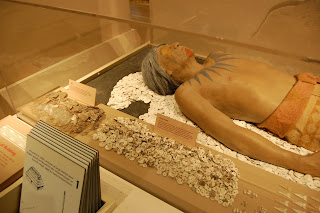Illinois is the Land of Lincoln and the city of Springfield, Illinois has a lot of museums, historic landmarks, memorials, and other historic sites dedicated to the 16th president, Abraham Lincoln, and the people that lived through the American Civil War fought from 1861 to 1865. Four years of terrible fighting that often tore apart families who disagreed on the subject of slavery claimed the lives of over one million people on the battle field and afterwards. In the end, slavery was ended and the Union was kept together. Abraham Lincoln was the last casuality when he was assassinated. According to wikipedia:
Hostilities began on April 12, 1861, when Confederate forces fired upon Fort Sumter, a key fort held by Union troops in South Carolina. Lincoln called for each state to provide troops to retake the fort; consequently, four more slave states joined the Confederacy, bringing their total to eleven.
For 4 years the United States had seperated into two countries, the Union and the Confederacy. My own relative (great-great-grandfather) fought in the Civil War on the Union side. He was from Wisconsin.
Historian John Huddleston estimates the death toll at ten percent of all Northern males 20–45 years old, and 30 percent of all Southern white males aged 18–40.Today we have many revisionists trying to rewrite the cause of this war and claim that slavery was not an issue. They call it by other names such as the War of Northern Aggression or the War between Brothers. In the end, the war per my research was over slavery.
The war produced about 1,030,000 casualties (3% of the population), including about 620,000 soldier deaths—two-thirds by disease, and 50,000 civilians.[210] Binghamton University historian J. David Hacker believes the number of soldier deaths was approximately 750,000, 20% higher than traditionally estimated, and possibly as high as 850,000.[211][212] The war accounted for roughly as many American deaths as all American deaths in other U.S. wars combined.[213]
The causes of the war, the reasons for its outcome, and even the name of the war itself are subjects of lingering contention today. Based on 1860 census figures, 8% of all white males aged 13 to 43 died in the war, including 6% in the North and 18% in the South.[214][215] About 56,000 soldiers died in prisons during the Civil War.[216] An estimated 60,000 men lost limbs in the war.[217]
One reason for the high number of battle deaths during the war was the use of Napoleonic tactics, such as charging. With the advent of more accurate rifled barrels, Minié balls and (near the end of the war for the Union army) repeating firearms such as the Spencer Repeating Rifle and the Henry Repeating Rifle, soldiers were mowed down when standing in lines in the open. This led to the adoption of trench warfare, a style of fighting that defined the better part of World War I.
The wealth amassed in slaves and slavery for the Confederacy's 3.5 million blacks effectively ended when Union armies arrived; they were nearly all freed by the Emancipation Proclamation. Slaves in the border states and those located in some former Confederate territory occupied prior to the Emancipation Proclamation were freed by state action or (on December 18, 1865) by the Thirteenth Amendment.
The war destroyed much of the wealth that had existed in the South. All accumulated investment in Confederate bonds was forfeit. Income per person in the South dropped to less than 40% than that of the North, a condition which lasted until well into the 20th century. Southern influence in the US federal government, previously considerable, was greatly diminished until the latter half of the 20th century.[218] The full restoration of the Union was the work of a highly contentious postwar era known as Reconstruction.Per some of my own research that is still ongoing, the number of slave owners was small compared to the population of the Confederacy. This research is still ongoing. What is interesting to me, is that there are those that are trying to hide this history just as they did the white slave history in the Colonies. Because of this, I will continue to research this subject and present data as it is found. For now, please enjoy the pictures from Springfield, Illinois:
Lincoln's Springfield Home
Lincoln Museum
Wax Replicas of the Lincolns and a guest
Inside the Lincoln Library
Lincoln's Tomb in Springfield
Lincoln's Tomb in Springfield
Camp Butler including over 1600 Civil War Dead (some were unknown soldiers)
Camp Butler including over 1600 Civil War Dead (some were unknown soldiers)
Old State Capitol
Inside Old State Capitol
Inside Old State Capitol
Inside Old State Capitol
Abraham Lincoln's Law Office
Post Office inside Abraham Lincoln's Law Office
by Rita Jean Moran (www.thelibrarykids.com)
Sources:
http://en.wikipedia.org/wiki/American_Civil_War
http://www.cem.va.gov/cems/nchp/campbutler.asp
http://en.wikipedia.org/wiki/Camp_Butler_National_Cemetery
http://en.wikipedia.org/wiki/Abraham_Lincoln













































.jpg)


.JPG)
















